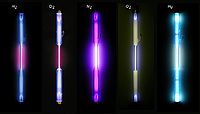
Photo from wikipedia
Cold field emission sources are capable of providing highly coherent and bright electron beams. However, they suffer from some well-known practical difficulties that have prevented their widespread use: unmanageably stringent… Click to show full abstract
Cold field emission sources are capable of providing highly coherent and bright electron beams. However, they suffer from some well-known practical difficulties that have prevented their widespread use: unmanageably stringent ultrahigh vacuum requirements, relatively large current instabilities, and rapid emission decays in periods as short as 1–2 h, requiring regular flashing (Joule heating). This paper presents the microfabrication and a successful emission test of a micron-sized concentric ring-graphene cathode cold field emitter, without any observable wall collapse. The cathode is designed to have a nanometer size ring-edge, while its radius can measure several microns or larger, providing stable electron emission under high vacuum conditions. The turn-on electric field of a ring-cathode source can be dramatically lowered by introducing a thin layer of nickel nanoparticles by an in-situ focused ion beam process. The dependence of field enhancement on the anode-cathode distance and the ring-cathode radius has been systematically studied.Cold field emission sources are capable of providing highly coherent and bright electron beams. However, they suffer from some well-known practical difficulties that have prevented their widespread use: unmanageably stringent ultrahigh vacuum requirements, relatively large current instabilities, and rapid emission decays in periods as short as 1–2 h, requiring regular flashing (Joule heating). This paper presents the microfabrication and a successful emission test of a micron-sized concentric ring-graphene cathode cold field emitter, without any observable wall collapse. The cathode is designed to have a nanometer size ring-edge, while its radius can measure several microns or larger, providing stable electron emission under high vacuum conditions. The turn-on electric field of a ring-cathode source can be dramatically lowered by introducing a thin layer of nickel nanoparticles by an in-situ focused ion beam process. The dependence of field enhancement on the anode-cathode distance and the ring-cathode ra...
Journal Title: Applied Physics Letters
Year Published: 2019
Link to full text (if available)
Share on Social Media: Sign Up to like & get
recommendations!